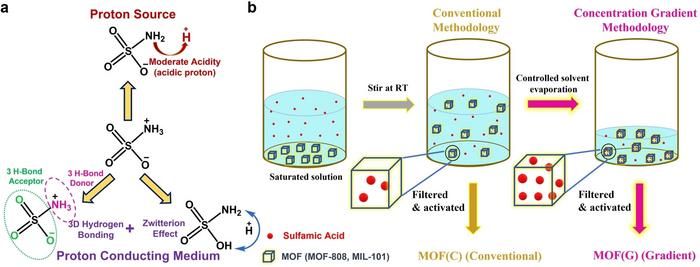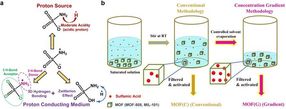New ionic materials boost hydrogen fuel cell efficiency!
This breakthrough contributes to accelerating progress toward sustainable energy solutions in line with global efforts towards decarbonization
Advertisement
A team of researchers, affiliated with UNIST has made a groundbreaking advancement in improving the efficiency of hydrogen fuel cells, which are gaining significant attention as eco-friendly next-generation energy sources.

Professor Myoung Soo Lah and his research team in the Department of Chemistry at UNIST
UNIST

Schematic Illustration of HSA Properties and Synthesis Methodology
UNIST


Led by Professor Myoung Soo Lah in the Department of Chemistry at UNIST, the team successfully developed solid electrolyte materials utilizing metal-organic frameworks (MOFs). This innovative approach significantly enhances the conductivity of hydrogen ions within the solid electrolyte employed in hydrogen fuel cells. Furthermore, the research team introduced guest molecules with low acidity—marking a pioneering achievement among intermediaries used for this purpose. By implementing a novel methodology that increases the number of guest molecules inside MOF pores, they achieved improved hydrogen ion conductivity.
Hydrogen fuel cells are highly efficient and environmentally friendly power generation devices that directly convert chemical energy derived from reactions between hydrogen and oxygen into electrical energy. Currently, Proton-Exchange Membrane Fuel Cells predominantly employ Nafion as an electrolyte material due to its thermal, mechanical, and chemical stability alongside high hydrogen ion conductivity. However, these systems face limitations regarding their operating temperature range and lack clarity on their mechanisms for performance enhancement.
The research team turned their attention to MOFs as potential alternatives. MOFs are materials composed of metal clusters interconnected by organic ligands to form a porous structure. With excellent chemical and thermal stability properties, MOFs have recently garnered considerable interest for use in fuel cell applications. Moreover, when generated, MOFs possess pores of varying sizes that can be utilized for developing materials with high hydrogen ion conductivity by introducing guest molecules through these channels.
In this study conducted by the research team at UNIST led by Professor Myoung Soo Lah’s group members , zwitterionic sulfamic acid—a low-acidity amphoteric ionic substance possessing both positive and negative charges—was introduced as guest molecules into two types of MOFs, namely MOF-808 and MIL-101. Sulfamic acid, a guest molecule with exceptional hydrogen bonding capabilities in various forms, effectively operates as a medium for transferring hydrogen ions. By increasing the amount of sulfamic acid within the pores of MOFs, the team successfully developed materials demonstrating high hydrogen ion conductivity (achieving levels of 10-1 Scm-1 or higher). Moreover, these materials exhibited remarkable durability as they maintained hydrogen ion conductivity over an extended period.
The research findings hold immense promise for advancing the efficiency and performance of hydrogen fuel cells through the utilization of metal-organic frameworks. This breakthrough contributes to accelerating progress toward sustainable energy solutions in line with global efforts towards decarbonization.
Original publication
Amitosh Sharma, Jaewoong Lim, Seonghwan Lee, Seungwan Han, Junmo Seong, Seung Bin Baek, Myoung Soo Lah; "Back Cover: Superprotonic Conductivity of MOFs Confining Zwitterionic Sulfamic Acid as Proton Source and Conducting Medium (Angew. Chem. Int. Ed. 29/2023)"; Angewandte Chemie International Edition, Volume 62, 2023-6-20
Other news from the department science
Most read news
More news from our other portals
See the theme worlds for related content
Topic World Battery Technology
The topic world Battery Technology combines relevant knowledge in a unique way. Here you will find everything about suppliers and their products, webinars, white papers, catalogs and brochures.

Topic World Battery Technology
The topic world Battery Technology combines relevant knowledge in a unique way. Here you will find everything about suppliers and their products, webinars, white papers, catalogs and brochures.




























































